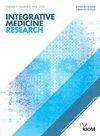Identification of auricular acupoints using a convolutional neural network
IF 3
4区 医学
Q2 INTEGRATIVE & COMPLEMENTARY MEDICINE
引用次数: 0
Abstract
Background
The accurate identification of acupoints is an essential task in acupuncture therapy. Recent advancements in artificial intelligence (AI) have led to the exploration of automated landmark detection systems, which may provide more accurate and reliable acupoint detection. This study investigated the efficiency of an AI model in predicting the shenmen, lung, and mouth auricular acupoints and compared its performance to placements made by a practitioner of traditional Korean medicine.
Methods
Ear images from 39 individuals were captured from three different angles. The mask region-based convolutional neural network (Mask R-CNN) model was utilized to isolate the ear region, followed by landmark detection using a CNN model trained on resized images to predict three auricular acupoints. Model reliability was enhanced by treating each acupoint as a separate prediction coordinate. Acupoint distribution was also estimated using a kernel density estimation method.
Results
Centroids of auricular acupoints predicted by the CNN model showed deviations of < 3 pixels from traditional placements by the practitioner. Kernel density estimation showed that CNN predictions led to narrower acupoint distributions compared with those placed by the practitioner, suggesting higher consistency in CNN model predictions across different images.
Conclusions
The AI-driven approach showed significant potential in improving both the accuracy and consistency of auricular acupoint identification. These findings support the integration of AI into acupuncture practice as a reliable tool for enhancing clinical accuracy and precision of acupoint location.
利用卷积神经网络识别耳穴
穴位的准确识别是针灸治疗中的一项重要任务。人工智能(AI)的最新进展导致了自动地标检测系统的探索,这可能会提供更准确和可靠的穴位检测。本研究调查了人工智能模型在预测肾、肺、口耳穴方面的效率,并将其性能与韩国中医的定位进行了比较。方法从3个不同角度采集39个个体的面部图像。利用基于掩膜区域的卷积神经网络(mask R-CNN)模型对耳区进行隔离,然后利用CNN模型对调整大小的图像进行训练,进行地标检测,预测三个耳穴。通过将每个穴位作为单独的预测坐标来提高模型的可靠性。用核密度估计法估计穴位分布。结果CNN模型预测的耳穴中心点与执业者的传统位置偏差为3个像素。核密度估计显示,CNN预测的穴位分布比医生预测的更窄,这表明CNN模型在不同图像之间的预测具有更高的一致性。结论人工智能驱动方法在提高耳穴识别的准确性和一致性方面具有显著的潜力。这些发现支持将人工智能整合到针灸实践中,作为提高临床准确性和穴位定位精度的可靠工具。
本文章由计算机程序翻译,如有差异,请以英文原文为准。
求助全文
约1分钟内获得全文
求助全文
来源期刊

Integrative Medicine Research
Medicine-Complementary and Alternative Medicine
CiteScore
6.50
自引率
2.90%
发文量
65
审稿时长
12 weeks
期刊介绍:
Integrative Medicine Research (IMR) is a quarterly, peer-reviewed journal focused on scientific research for integrative medicine including traditional medicine (emphasis on acupuncture and herbal medicine), complementary and alternative medicine, and systems medicine. The journal includes papers on basic research, clinical research, methodology, theory, computational analysis and modelling, topical reviews, medical history, education and policy based on physiology, pathology, diagnosis and the systems approach in the field of integrative medicine.
 求助内容:
求助内容: 应助结果提醒方式:
应助结果提醒方式:


